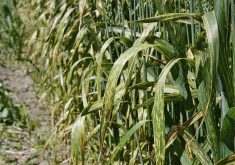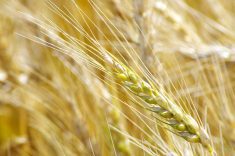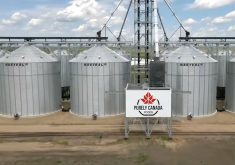Global economies appear to be “falling off a cliff,” with reduced demand for crude oil and other commodities pressuring grain prices downward, says an Alberta-based commodities analyst.
At the same time, lower than expected U.S. corn yields are supporting canola, wheat and soybean prices, said Errol Anderson, president of ProMarket Communications.
Be ready to move quickly and take advantage of price rallies this fall and winter, he advised.

“The big hint is corn yields in the States. The Pro Farmer Crop Tour has been in progress, and they came out with an average corn yield estimate of 168.5 bushels per acre,” Anderson said on Aug. 31, and corn is considered “the king of grains” when it comes to price forecasting.
Read Also

Hail research hopes to benefit potato growers
Alberta research scientist measures hail storm and heat dome affects on potato crops
“That surprised the market because it’s lower, so the corn market has really been a driver recently. This contributed support to canola, to wheat and soybeans … so it pulled us up.”
Falling demand for crude oil, “the king of commodities”, is another big-picture indicator, he said, noting corn is a major feedstock for ethanol. The oil price drop is a warning that demand from Asia is poor.
“Our view on the grains is, when you see these rallies like corn is doing right now, these are opportunities to do some pricing, because all of a sudden these markets will start to come down,” Anderson said during an end-of-month interview. “Now, looking at the local prices, canola basically has done well. It’s holding in there.”
It was nice to have grain to sell before prices dropped, said Jason Lenz, vice-chair of Alberta Wheat, adding that canola prices are still at profitable levels.
“I think they are going to stay relatively high for the rest of this year if the war in Ukraine continues.”
Feed barley prices could also remain strong due to lower-than-expected corn yields in the U.S., said Lenz, who farms near Bentley. Also, it only takes one severe weather event in another major grain producing country to boost Canadian prices.
“I’ll be concerned about falling prices if our input costs like fertilizer stay high,” he said. “Everything goes down a lot faster than it goes up.”
If crude oil falls below US$80 a barrel, canola prices will likely fall because they’re tied to biodiesel production, said Anderson, adding he suspects oil has more downside because of a contracting global economy. The price did fall below $82 during the first week of September before rebounding somewhat as this issue was going to press.
“The Saudis certainly want to keep this price up, and they are threatening to cut production,” he said. “They are not able to hold it because now the commodity prices are being dictated by demand, not supply. You can talk all you want about shrinking supply, but if the demand isn’t there, then who cares? The prices will fall anyway.”
While canola is doing well, wheat has dropped. Ukrainian grain making its way out of Black Sea ports into export markets could keep wheat prices down, said Anderson, calling the wheat market “dozy.” He is “mildly optimistic” about barley prices.
“Once we get into the fourth quarter, barley prices will start to go back up a bit. There’s no export market for barley right now, like it’s not cheap enough for the Chinese to come in so it’s really just a local domestic market.”
He expects a floor in the pea market to emerge this month “ but the international buyers are really, really quiet,” he said. “It might be kind of a painfully slow process to recover. Maybe late fall, prices will start to improve.”
Durum and oat prices are also well off their highs but price rallies are likely this fall and winter, said Anderson.
He urged farmers to keep an eye on local basis levels because they track buyer demand.
“If the basis levels get really, really wide, that’s when they should lock in the futures or get put options, things like that,” he said. “The flip side is, if the basis level gets really snug because of buyer demand, that’s a good time to cash out on grain. And if they are bullish for the winter market, then grab some call options.”

There’s a lot of uncertainty in grain markets and farmers who can afford to be patient might benefit from higher prices, said Jonathon Driedger of LeftField Commodity Research, noting there are still significant problems with grain exports in Ukraine. He said grain prices remain comparatively high.
“I’d like to say there are easy answers,” said Driedger when asked about priorities for farmers. “There are reasons why prices could or should maybe stay supported or rebound, those sorts of things, and it wouldn’t be hard to build a list of reasons why there could be some upside here. It’s really dry in the EU and uncertainty over planting in Ukraine.”
Grain prices are under normal seasonal pressure, said Driedger, so it could take time for prices to regain their footing.
“If a person needs to sell grain in the next short window, this is a time when prices normally come under some pressure so maybe in some ways, how patient a farmer can or can’t be is one thing to consider.
“I think the combination of timing and risk appetite and tolerance are two important things they need to think about. If you haven’t priced anything, most of these crops still have pretty good prices, so you might want to get something done.”















